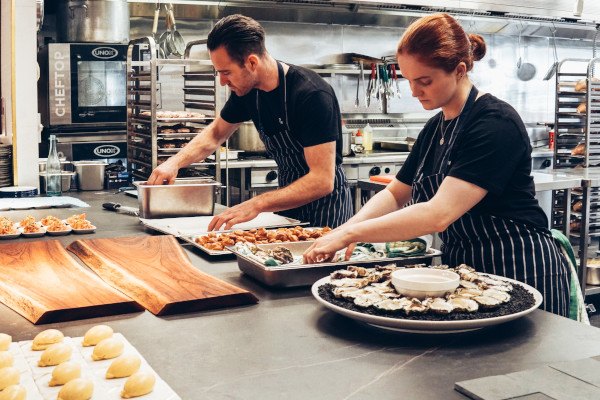How Can Your Restaurant Beat The Effects of Inflation With A POS?
As operation costs and minimum wages continue to rise, restaurants are forced to increase menu prices, while consumers are starting to look for dining options that offer more value. How can your restaurant combat inflation and stay on top of its game during a global crisis?
The great news is that a modern point of sale (POS) system can help restaurants fight inflation by providing tools to manage costs and optimize operations.
There’s no one-size-fits-all solution to tackling inflation, but here are ways you can combat it and how a smart and intuitive POS can keep your restaurant business up and thriving while inflation is at an all-time high.
Effects of Inflation to Restaurants in 2023

Inflation refers to the general increase in the price level of goods and services in an economy over time. Inflation reduces the buying power of money, which means that the same amount of money now only buys slightly fewer goods and services than it did before. This may impact restaurant businesses in a number of ways, including:
Increased ingredient costs: Inflation can cause the cost of ingredients to rise, making it more expensive for restaurants to prepare their dishes. This can impact a restaurant’s profit margins and force them to raise their prices or find ways to cut costs.
Higher labor costs: Inflation can also lead to higher labor costs, as employees may demand higher wages to keep up with the rising cost of living. This can make it more expensive for restaurants to hire and retain staff, impacting the quality of service they provide.
Reduced customer spending: Inflation can cause consumers to be more price-sensitive and cut back on their spending, impacting restaurants' sales. If customers spend less money overall, they may be less likely to eat out or order delivery, resulting in lower restaurant revenues.
Increased competition: If inflation is widespread across the economy, it may impact other businesses in the restaurant’s market. For example, consumers spending less money overall may be more likely to choose cheaper fast food options over more expensive sit-down restaurants. This can increase competition and make it more difficult for restaurants to maintain their customer base.
In summary, inflation can negatively affect restaurants, through increased ingredient and labor costs, reduced customer spending, and increased competition. To mitigate these effects, restaurants need a restaurant POS to cut costs, adjust their menu prices, and focus on maintaining customer loyalty and satisfaction. This is one way to overcome the effects of inflation and increase the effectiveness of your business.
How Can Your Restaurant Combat the Effects of Inflation?

Lean into loyalty
Rewards programs can offer diners discounts, but only if they earn points through repeat business. According to Rewards Network's survey, 73% of restaurants with a rewards program found these programs particularly important during this time. Over the past year, almost every major chain—including Panera, P.F. Chang’s, Dunkin’, Rubio's, and Zaxby's—added or revised their programs to offer loyal customers discounts and to also track customer data.
Closely monitor food inventory
Not counting your inventory regularly can lead to expensive food waste. Counting inventory weekly, if not daily, is best to avoid over-purchasing. Employees with experience should be in charge of food ordering, and your restaurant can also reach out to new suppliers to see if you can provide cheaper products at the same quality level as existing partners offer.
Optimize menus
Restaurants are reducing their menu offerings. Thirty-one percent of operators report trimming their menus, while 30% said they have switched to lower-cost ingredients. It's best to rely on your point-of-sales data to determine which items sell well and which low-selling items can be scratched off the menu.
Recently, restaurants have been using technology to understand historical sales volume in real-time better. You can also use operational financial dashboards like Microsoft’s Power BI and Salesforce’s Tableau to process historical sales volume by day or hour. This move has allowed many restaurants to be more discerning with menu cuts.
Restaurants are also reducing the size of their food menus to focus on the main items that are easy to source from their suppliers consistently. Smaller menus also allow restaurants to manage food costs and quantity better, making inventory tracking easier. It’s also easier for a new employee to learn how to cook a smaller menu which can benefit restaurants struggling with turnover.
Promote higher-profit items
It's helpful to take inventory of top-selling and higher-priced items to understand how they impact costs. If it’s not possible for you to reduce portion sizes, higher-profit items can help boost margins. As you promote these items, you don’t have to push for heavy discounts. Higher-profit items such as beverages can be promoted, as well as sides and appetizers with low operating costs.

Add menu items when it makes sense
If your restaurant has a distinct concept with a more specific customer base, it helps to add one or two things that can attract a bigger audience. For example, you can throw a burger to a sandwich menu if you didn't have that before or add comfort foods to a health-centric restaurant menu.
Beef up employee benefits
A smart restaurant operator will never disregard their employees' benefits. As minimum wages soar this time, health insurance, mental health benefits, and retirement plans will keep them happy to work with you. Employee benefits like these can help reduce turnover, which increases restaurant costs. New employees don’t produce as many sales as tenured employees, so it's smart to focus on keeping your old ones happy instead of acquiring new ones. This way, you don’t have to take time away to train new workers so you can focus more on growing sales.
Emphasize quality
Emphasize that you are still using quality ingredients and that the price increase will ensure that the quality of the product remains the same. You can communicate this quality by adding descriptions on your website menu items. Another way to emphasize quality is to ensure the restaurant is clean and customer service is exemplary at every touchpoint.
If you do this, even if you increase the prices of your items, you can still get whatever price you put out if you can guarantee excellent service and top-notch food quality.
Point-of-Sales technology to Combat Restaurant Inflation

Now is the best time to invest in point-of-sales systems that can help monitor menu pricing and manage inventory. Modern restaurant POS can order products, manage inventory and even monitor loyalty points and employee performance based on historical sales data. POS systems can help automate these processes so you can focus on growing your business.
Employers should also lean into technology as it can help create a less stressful environment and chaos in the kitchen.
Menu price adjustments
A POS system can help a restaurant keep track of your costs and profits, which allows you to make informed decisions about adjusting menu prices in response to inflation. By analyzing sales data and cost information, you can determine which menu items are more profitable and which ones may need to have their prices adjusted.
Inventory management
Inflation can cause the cost of ingredients to rise, which can impact a restaurant's profit margins. By using a POS system with inventory management capabilities, you can closely monitor your inventory levels and track the cost of ingredients. This can help identify areas where you may be overspending and make adjustments to your ordering and inventory management processes.
Customer loyalty programs
Inflation can cause customers to be more price-sensitive, which can make it more difficult for restaurants to maintain their customer base. By using a POS system to track customer data and implement loyalty programs, restaurants can encourage repeat business and reward loyal customers. This can help offset the impact of inflation on sales by creating a base of customers who are willing to pay a premium for their food and experience.
Cost-cutting measures
Inflation can also inspire restaurants to look for ways to cut costs without sacrificing quality or service. A POS system can provide valuable data on labor costs, inventory levels, and other expenses, which can help restaurants identify areas where they can cut costs. For example, you may be able to reduce food waste by better managing inventory, or streamline your ordering process to reduce labor costs.
Overall, a POS system can be a valuable tool for restaurants to fight inflation by helping them manage costs, adjust menu prices, and maintain customer loyalty. By taking advantage of the insights and data provided by a POS system, restaurants can make informed decisions that help them thrive in a changing economic landscape.
-
 1
1



0 Comments
Recommended Comments
There are no comments to display.
Please sign in to comment
You will be able to leave a comment after signing in
Sign In Now